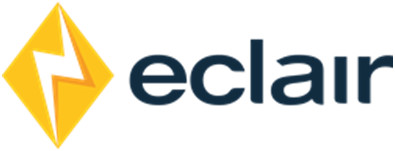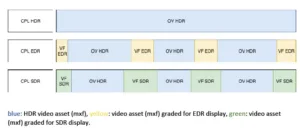Éclair, which is part if the Ymagis Group, used CinemaCon 2018 to unveil a new Hybrid Tone Mapping (HTM) approach for creating an HDR cinema master and other deliverables including the SDR DCI version.
To learn more, we met with Cedric Lejeune, VP Technology & Innovation at Éclair Cinema. He started by explaining that the problem they want to solve is the many versions of the movie DCP that must be generated to fit all the screens and formats now available in theaters. He also made some provocative statements such as:
- Automated tone mapping doesn’t work very well for playback on a lower grade projector
- Grading with metadata is good, but adds cost for playback at the lower grade projector
- PQ doesn’t work for cinema; It is best for archiving as it is an absolute EOTF
- PQ is not best for coding efficiency, especially when coupled with XYZ color representation
Instead, his team has developed EclairColor HDR. This is an EOTF based on using gamma 2.8 which Lejeune says is applicable for dynamic range of 20K:1 and peak luminance of 300 cd/m².
Lejeune then explained how he envisions Hybrid Tone Mapping working. To begin, he sees ungraded content arriving in an ACES AP1 format. Using Resolve, Baselight or some other color grading system, the colorist would select the EOTF for the HDR master. One example would be the EclairColorHDR EOTF with grading done on a Samsung LED screen (as was done at the Roundabout post production house recently). His “hero” grade uses EclairColor HDR and ACES AP1 to create the Digital Cinema Package (DCP) as a deliverable.
 Next, the colorist would select the next EOTF to grade for, perhaps the Dolby Cinema EDR version using the PQ EOTF with a peak luminance of 110 cd/m², for example. The colorist would review the movie and make adjustments as needed to maintain the same look and feel at this reduced luminance. But instead of saving these changes as metadata, they would be rendered as separate files and added to the DCP. This change becomes codified in the Composite Play List (CPL) with a time code and included as part of the DCP. The colorist continues in this way, changing scenes as needed and generating new scene files and adding to the CPL. To play back the Dolby Cinema version, the IMB now runs the main DCP, swapping out the modified files at the appropriate time per the CPL.
Next, the colorist would select the next EOTF to grade for, perhaps the Dolby Cinema EDR version using the PQ EOTF with a peak luminance of 110 cd/m², for example. The colorist would review the movie and make adjustments as needed to maintain the same look and feel at this reduced luminance. But instead of saving these changes as metadata, they would be rendered as separate files and added to the DCP. This change becomes codified in the Composite Play List (CPL) with a time code and included as part of the DCP. The colorist continues in this way, changing scenes as needed and generating new scene files and adding to the CPL. To play back the Dolby Cinema version, the IMB now runs the main DCP, swapping out the modified files at the appropriate time per the CPL.
Other versions like the IMax and then the SDR 48 cd/m² version can be created in the same way. Lejeune says all these files and CPL data can be added efficiently to the DCP allowing for a single deliverable without any increase in file size. The exhibitor only received the Key Delivery Message (KDM) for the right CPL for their particular projection system. However, he did not discuss various audio tracks, subtitles, languages and other format and resolution changes that are also part of the versioning process.
Lejeune says that Ymagis holds patents on this process and that the group would likely seek licensing fees and/or royalties from the studios or post houses to use HTM. The HTM solution offers a multi-display DCP (MD DCP – Multi-dynamic Digital Cinema Package) that comes with special software, MD Map (Multi-dynamic Mapping), that is said to be easily integrated in projection systems through regular updates, as well as current or future LED displays. MD DCPs are “fully compatible” with all types of projection systems and LED cinema screens. By incorporating specific settings in the DCP, the same content can be played via a standard projection system in SDR format as well as in HDR, whether the equipment is an EclairColor HDR-certified projector or simply HDR-ready. – CC

